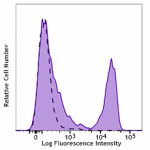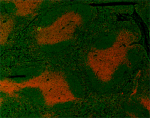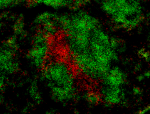- Clone
- KT3.1.1 (See other available formats)
- Regulatory Status
- RUO
- Other Names
- CD3e, T3e
- Isotype
- Rat IgG2a, κ
- Ave. Rating
- Submit a Review
- Product Citations
- publications
CD3ε is a 20 kD transmembrane protein, also known as CD3 or T3. It is a member of the Ig superfamily and primarily expressed on T cells, NK-T cells, and at different levels on thymocytes during T cell differentiation. CD3ε forms a TCR complex by associating with the CD3δ, γ and ζ chains, as well as the TCR α/β or γ/δ chains. CD3 plays a critical role in TCR signal transduction, T cell activation, and antigen recognition by binding the peptide/MHC antigen complex.
Product DetailsProduct Details
- Verified Reactivity
- Mouse
- Antibody Type
- Monoclonal
- Host Species
- Rat
- Immunogen
- CBAT6 Thymocytes
- Formulation
- Phosphate-buffered solution, pH 7.2, containing 0.09% sodium azide
- Preparation
- The antibody was purified by affinity chromatography and conjugated with Spark Red™ 718 under optimal conditions.
- Concentration
- 0.2 mg/mL
- Storage & Handling
- The antibody solution should be stored undiluted between 2°C and 8°C, and protected from prolonged exposure to light. Do not freeze.
- Application
-
FC
- Recommended Usage
-
Flexi-Fluors™ are provided at a standard 0.2 mg/mL concentration. We recommend titrating this reagent to determine the optimal concentration for each application. For many flow cytometry applications, conjugated antibodies perform well at concentrations ranging from 0.03 to 1.0 µg per million cells in 100 µL. We recommend testing a range of concentrations starting from 10 µg/mL.
For example, make five 1:1 serial dilutions of the 0.2 mg/mL antibody. Add 5 µL of each dilution (including the undiluted antibody) to 100 µL of cells (at 107 cells/mL) to test six concentrations -- 1.0, 0.5, 0.25, 0.125, 0.06, and 0.03 µg per million cells in 100 µL volume. Compare staining patterns or create a titration curve using the MFI or staining index to determine the optimal concentration.
* Spark Red™ 718 has a maximum excitation of 697 nm and a maximum emission of 711 nm. - Excitation Laser
-
Red Laser (633 nm)
- Additional Product Notes
-
For more information about Flexi-Fluors™, visit our Flexi-Fluor™ page and review FAQs associated with this product line.
- Application References
-
- Tomonari K. 1988. Immunogenetics. 28:455. (FC)
- RRID
-
AB_3106338 (BioLegend Cat. No. 285083)
Antigen Details
- Structure
- Ig superfamily, forms CD3/TCR complex with CD3δ, γ and ζ subunits and TCR (α/β and γ/δ), 20 kD.
- Distribution
-
Thymocytes (differentiation dependent), mature T cells, NK-T cells
- Function
- TCR signal transduction, T cell activation
- Ligand/Receptor
- TCR
- Cell Type
- NKT cells, T cells, Thymocytes, Tregs
- Biology Area
- Immunology
- Molecular Family
- CD Molecules, TCRs
- Antigen References
-
- Preston S, et al. 1997. Eur. J. Immunol. 27:1911.
- Davis MM. 1990. Annu. Rev. Biochem. 59:475.
- Weiss A, Littman DR. 1994. Cell. 76:263.
- Gene ID
- 12501 View all products for this Gene ID
- UniProt
- View information about CD3epsilon on UniProt.org
Related FAQs
- What are Flexi-Fluors?
-
Flexi-Fluors are rapidly made-to-order conjugated antibodies. The technology, manufacturing processes, and specifications used to create Flexi-Fluors are the same as our regular catalog products. However, the optimal concentration and performance of each Flexi-Fluor must be determined by the customer.
- How quickly will I receive my order?
-
We aim to ship Flexi-Fluors within 2-3 weeks of receipt of your order. However, depending on your location, shipping times may vary.
- How are Flexi-Fluors different from regular catalog products?
-
Flexi-Fluors are made on demand, specifically for you. Flexi-Fluors are manufactured using the same high-quality standards, and specifications as other catalog products. For faster delivery, Flexi-Fluors are not tested by flow cytometry to determine optimal concentrations or evaluate performance. This testing needs to be performed by the customer.
- How do I determine the optimal concentration for using my Flexi-Fluor? How should I titrate my antibody?
-
Flexi-Fluors are provided at a standard 0.2 mg/mL concentration. We recommend that you titrate your antibody to determine the optimal concentration to use for your application. For many flow cytometry applications, conjugated antibodies perform well at concentrations ranging from 0.03 to 1.0 µg per million cells in 100 µL volume. We recommend that you test a range of concentrations starting from 10 µg/mL.
For example, make five 1:1 serial dilutions of your 0.2 mg/mL antibody. Add 5 µL of each dilution (including the undiluted antibody) to 100 µL of cells (at 107 cells/ml) to test six concentrations - 1.0, 0.5, 0.25, 0.125, 0.06, and 0.03 µg per million cells in 100 µL volume. Compare staining patterns or create a titration curve using the MFI or staining index to determine the optimal concentration.
- I can’t find the antibody-dye combination that I need. When will it be available?
-
We continuously update our catalog, introducing scores of new products every month. Please get in touch with our Technical Service team for an update on new products or recommendations for suitable alternatives to complete your panel. Or contact Custom Solutions to inquire about our affordable custom conjugation services.
- I need help to validate the performance of my Flexi-Fluor. Who should I contact?
-
Please get in touch with Technical Service for assistance.
- Can I order more than 50 μg of a Flexi-Fluor?
-
Yes, you can order multiple vials of the same Flexi-Fluor products. We cannot guarantee, however, that these vials will be bottled from the same lot. For bulk single-lot orders, contact our Custom Solutions team.
- What is the expiration date of my Flexi-Fluor?
-
Expiration dates can be found on the vial label or by using our CoA lookup tool.
Other Formats
View All CD3ε Reagents Request Custom Conjugation| Description | Clone | Applications |
|---|---|---|
| Purified anti-mouse CD3ε | KT3.1.1 | FC,IHC-F |
| FITC anti-mouse CD3ε | KT3.1.1 | FC |
| PE anti-mouse CD3ε | KT3.1.1 | FC |
| APC anti-mouse CD3ε | KT3.1.1 | FC |
| Pacific Blue™ anti-mouse CD3ε | KT3.1.1 | FC |
| Alexa Fluor® 647 anti-mouse CD3ε | KT3.1.1 | FC,IHC-F |
| APC/Fire™ 750 anti-mouse CD3ε | KT3.1.1 | FC |
| PerCP/Cyanine5.5 anti-mouse CD3ε | KT3.1.1 | FC |
| Brilliant Violet 421™ anti-mouse CD3ε | KT3.1.1 | FC |
| PE/Dazzle™ 594 anti-mouse CD3ε | KT3.1.1 | FC |
| PE/Cyanine7 anti-mouse CD3ε | KT3.1.1 | FC |
| Spark Red™ 718 anti-mouse CD3ε (Flexi-Fluor™) | KT3.1.1 | FC |
Compare Data Across All Formats
This data display is provided for general comparisons between formats.
Your actual data may vary due to variations in samples, target cells, instruments and their settings, staining conditions, and other factors.
If you need assistance with selecting the best format contact our expert technical support team.
-
Purified anti-mouse CD3ε

C57 splenocytes were stained with purified CD3ε (clone KT3.1... 
C57BL/6 mouse frozen spleen section was fixed with 4% parafo... -
FITC anti-mouse CD3ε

C57BL/6 mouse splenocytes were stained with CD3ε (cl... -
PE anti-mouse CD3ε

C57BL/6 mouse splenocytes were stained with FITC anti-mouse ... -
APC anti-mouse CD3ε

C57BL/6 mouse splenocytes were stained with FITC anti-mouse ... -
Pacific Blue™ anti-mouse CD3ε

C57BL/6 mouse splenocytes were stained with FITC anti-mouse ... -
Alexa Fluor® 647 anti-mouse CD3ε

C57BL/6 mouse splenocytes were stained with FITC anti-mouse ... 
C57BL/6 mouse frozen spleen section was fixed with 4% parafo... -
APC/Fire™ 750 anti-mouse CD3ε

C57BL/6 mouse splenocytes were stained with CD45R/B220 FITC ... -
PerCP/Cyanine5.5 anti-mouse CD3ε

C57BL/6 mouse splenocytes were stained with CD45R/B220 FITC ... -
Brilliant Violet 421™ anti-mouse CD3ε

C57BL/6 mouse splenocytes were stained with APC anti-mouse C... -
PE/Dazzle™ 594 anti-mouse CD3ε

C57BL/6 mouse splenocytes were stained with APC anti-mouse C... -
PE/Cyanine7 anti-mouse CD3ε

C57BL/6 mouse splenocytes were stained with CD45R/B220 FITC ... -
Spark Red™ 718 anti-mouse CD3ε (Flexi-Fluor™)
 Login / Register
Login / Register 













Follow Us